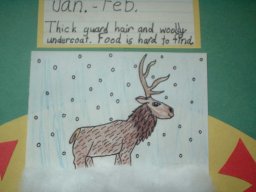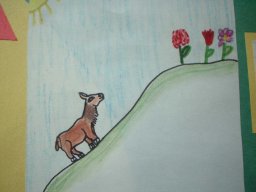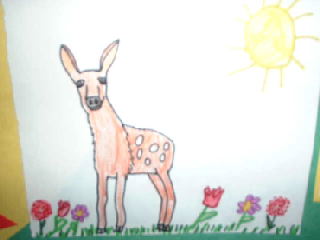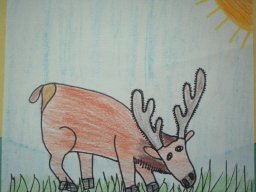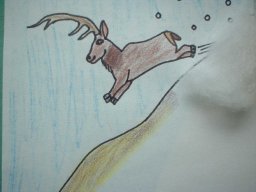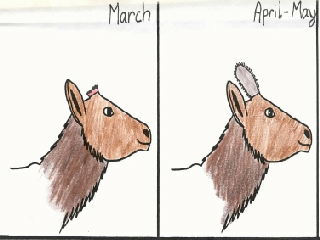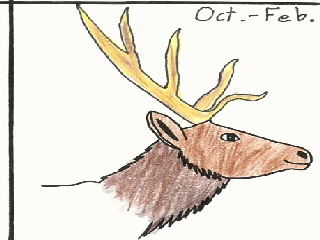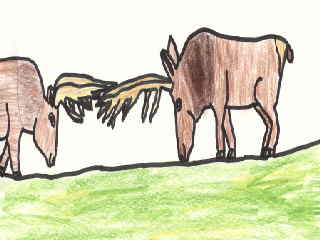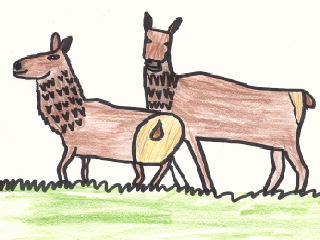|
I decided to take a different approach to the “Spring Into Life Project.” I am presenting this as another example of how Susan and Pattie’s wonderful project can be used. Instead of using the topic for the whole class, I used it as an enrichment activity for one of my students who needs extra challenges. This project provided an opportunity for Aaron to do a little “Mini-Research” on an animal that he would encounter during the family vacation. Aaron’s Report on THE ELK I researched the Elk because I am going to Colorado and hope to see Elk. I also wanted to learn a little so when I get there I know the stages of antler growth and how they live. The elk go uphill in the summer and downhill in the winter because it is easier to find food that way. They also get away from predators by the snow not being so deep downhill. Running in the water is harder than running on land, it slows you down. The elk also have two coats. The two coats have thick fur that keep them warm in the winter. The top coat hairs are called guard hairs. They are long strips of fur that are also thick. The undercoat is thick and short.
In January - February, the elk have thick guard hair and a wooly undercoat. Food is hard to find.
From March-April the elk come up from the valleys to eat fresh plant shoots.
In May-June calves are born with freckled coats for camouflage.
From July-August elk have their short summer coat. Food is Plentiful.
In the months of September-October, the rutt begins. Males fight to win the harem of cows.
In the months of November-December the elk move down to valleys where there is less snow and food is easier to find. That was not the only thing that was interesting to me. The antlers are also very important. The elk use their antlers mostly for defense.
In March the antlers fall off of the elk. In April they start to grow back.
Velvet helps bring nutrients to the antlers so they can grow faster. The velvet also protects the antlers. The antlers are made out of bone !
Then eventually, the velvet starts to dry and falls off in August.
By September-October, the antlers are full grown! Then, the antler growth happens all over again.
Then comes the rutt in October. The elk fight can take a few seconds or a few minutes , and sometimes they won’t fight at all. If there is a real big one, the small one will not fight with it. Then the elk save their strength for the next year.
Well that is what I learned about the elk. I can’t wait for summer vacation so I can see them. Aaron’s List of Elk Books: 1. Nature’s Children - Elk by Pamela Martin 2. Deer and Elk by D. H. Patent 3. Teddy Roosevelt’s Elk by Brenda Z. Guiberson 4. Rocky Mountain National Park - A Wildlife Watcher’s Guide Some Web Sites to Explore NETS for Students 1. Basic operations and concepts Students are proficient in the use of technology. 2. Social, ethical, and human issues Students develop positive attitudes toward technology uses that support lifelong learning, collaboration, personal pursuits, and productivity. 3. Technology productivity tools Students use productivity tools to collaborate in constructing technology-enhanced modesl, preparing publications, and producing other creative works. 4. Technology communications tools Students use telecommunications to collaborate, publish, interact with peers, experts, and other audiences. Whitefish Bay Technology Standards grades K-2 Standard One Students will demonstrate the ability to use a variety of technology in order to facilitate and demonstrate learning. Standard Two Students will use technology to communicate in different ways. Standard Three Students will understand and operate computer systems and other hardware. Standard Four Students will understand and use rules of ethics and responsibility in use of technology. Whitefish Bay Language Arts Standards K-2 READING: Standard One Students will demonstrate competence in the general skills and strategies of the reading process. Standard Two Students will demonstrate competence in general skills and strategies for reading a variety of literary texts. Standard Three Students will demonstrate competence in the general skills and strategies for reading a variety of informational texts. WRITING: Standard Four Students will demonstrate competence in the general skills and strategies of the writing process. Standard Five Students will demonstrate competence in the stylistic and rhetorical aspects of writing. Standard Six Students will use grammatical and mechanical conventions in written compositions. Standard Seven Students will effectively gather and use information for research purposes. LISTENING AND SPEAKING: Standard Eight Students will demonstrate competence in speaking and listening as tools for learning. MEDIA LITERACY: Standard Nine Students will demonstrate the ability to evaluate, create, analyze, and edit media. Science: Students will know about the diversity and unity that characterize life. |
